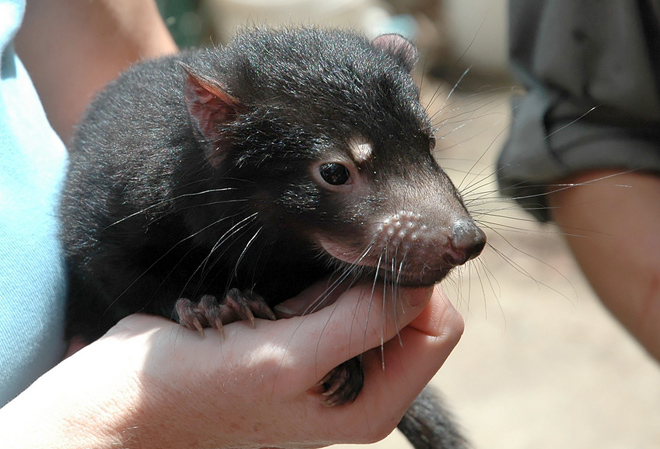Please note: Osher Rainforest will be closed for maintenance May 7-9.
Science News
Saving Devils through DNA
July 1, 2011

This week, an international group of researchers published the results of comprehensive genomic study of Tasmanian devils in the Proceedings of the National Academy of Sciences. In this case, it’s not just about getting to know the species for knowledge sake: the scientists are actually hoping to protect and save the endangered devils.
For the past fifteen years, Tasmanian devils have been facing a terrifyingly deadly cancer known as Devil Facial Tumor Disease (DFTD). Terrifying because DFTD is a contagious cancer. (Radiolab did an excellent story about DFTD last year with science writer David Quammen—check it out to learn more about how cancer can spread this way.)
“The disease is like nothing we know in humans or in virtually any other animal. It acts like a virus but it actually is spread by a whole cancerous cell that arose in one individual several decades ago,” explains co-author Stephan Schuster of Penn State University. “This malignant cell is transferred directly from one individual to another through biting, mating, or even touching. Just imagine a human cancer that spread through a handshake. It would eradicate our species very quickly.”
To prevent that from happening to Tasmanian devils, the team of scientists proposes that a number of healthy individuals can be kept in zoos and other facilities in “protective custody” until the tumor runs its course and disappears in the wild. Then the captive animals could be released back into their former habitat and the population could begin to grow anew.
Team member Webb Miller of Penn State cautions that it’s not as easy as it sounds. “It’s not just a matter of scooping up a few individuals at random and locking them away. Our team developed a smarter, more calculated approach: We asked ourselves, which individuals would be the best candidates for ‘protective custody,’ and what criteria would we use to make those determinations? We soon realized that the answer was to compile genetic data and to analyze it in novel ways."
First, the researchers sequenced the complete genomes – 3.2 billion base pairs each—of two individual Tasmanian devils. One was a male called “Cedric,” who had a natural resistance to two strains of DFTD, but succumbed after being infected with a different strain of the disease last year. The other was a female called “Spirit,” who had contracted the vicious cancer in the wild. Because the two animals had originated in the extreme northwest and southeast regions of Tasmania, respectively, they represented the maximal geographic spread of the species—a measure used as an approximation of genetic diversity.
The genetic diversity of the Tasmanian devil population is low to begin with. For this reason, choosing the right individuals to represent the broadest genetic diversity possible is critical for successful species preservation. “It might seem you’d want to choose only those individuals that are genetically resistant to the DFTD cancer. However, that would defeat the purpose of maintaining genetic diversity because, by definition, you’d be selecting a tiny subset of the gene pool,” Schuster says. “Instead, our model suggests a more balanced approach. You don’t want to put out just the one fire—the cancer. Instead, you want to develop a pool of diverse, healthy individuals that can fight future maladies or even pathogens that have not yet evolved.”
The second part of the project was to learn how much genetic diversity had been lost since Europeans settled Tasmania in 1803. To do this, the scientists analyzed a large number of genetic markers from an additional 175 Tasmanian devils, some of which were museum specimens from the Smithsonian and the Natural History Museum in London. Schuster explains that this approach to genomic research, which he has named “museomics,” is truly unique and brimming with potential. “Museums are treasure troves of specimens collected in the last 250 years,” Schuster says. “And, in fact, we can get DNA from hair shafts of a museum specimen.”
Interestingly, after analyzing the 175 individuals, the scientists learned that the genomic diversity of the Tasmanian devil, while low, has not decreased much over the last century. “This is an important finding because it means that DFTD is not to blame for any lack of genetic diversity since the disease appeared only 15 years ago,” Miller explains. “It’s crucial that we act as responsible stewards for the species, helping maintain what little genetic diversity it had before the DFTD epidemic struck.”
Schuster agrees. “To plan for the future, you have to be willing to understand the past. It’s important to examine museum specimens, as well as the population history of species over the last 10,000 to 50,000 years, and to use that genetic data to formulate a plan. The idea is to save a species, not to do a ‘post-mortem’ on it.”
Image: Stephan Schuster